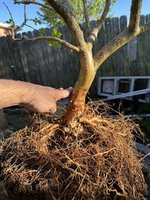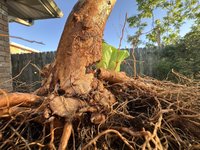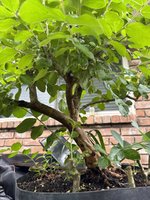Nursery took 75% off this crape myrtle. So did I.
- Thread starter BillsBayou
- Start date
BillsBayou
Chumono
Update 1:
I repotted the tree the same day I bought it. Each photo, below, will have some notes about what is going on.
Nursery repottings are horrible for bonsai design. Employees will pull a tree from its pot, drop it in a larger pot, then cover the roots with soil. The first thing to do with nursery trees is remove this soil and start looking for the base of the tree. In this case, I've already started removing poorly placed roots. They'll never look good, so remove them now. Even so, the trunk still looks like it is disappearing into the root ball rather than showing me its base.

Things are looking bad from this angle. Same progress as the photo, above. Note the crossing root at the trunk on the lower left. It has dug in. This tree is going to have a ways to go before any base can be developed.

My hand is at the original soil line. The crossing root, above, has been removed. The black scar is on the lower right. I made a decision on the base of the tree. In this case it is where I have enough roots at the base of the tree, but going any deeper will create too many scars for my liking.

Another view from the other side. The taper on the trunk may not be the best, but this will look better over time.

A close up of the scar from the crossing root. This gap is better than the crossing root. The root was never going to look good. However, this scar can be managed if the base fattens up at the soil line.

I repotted the tree the same day I bought it. Each photo, below, will have some notes about what is going on.
Nursery repottings are horrible for bonsai design. Employees will pull a tree from its pot, drop it in a larger pot, then cover the roots with soil. The first thing to do with nursery trees is remove this soil and start looking for the base of the tree. In this case, I've already started removing poorly placed roots. They'll never look good, so remove them now. Even so, the trunk still looks like it is disappearing into the root ball rather than showing me its base.

Things are looking bad from this angle. Same progress as the photo, above. Note the crossing root at the trunk on the lower left. It has dug in. This tree is going to have a ways to go before any base can be developed.

My hand is at the original soil line. The crossing root, above, has been removed. The black scar is on the lower right. I made a decision on the base of the tree. In this case it is where I have enough roots at the base of the tree, but going any deeper will create too many scars for my liking.

Another view from the other side. The taper on the trunk may not be the best, but this will look better over time.

A close up of the scar from the crossing root. This gap is better than the crossing root. The root was never going to look good. However, this scar can be managed if the base fattens up at the soil line.

BillsBayou
Chumono
Update 2: The tree exploded.
As I expected, the tree rewarded me with an explosion of growth. Flower buds developed while I was in Denver at the ABS convention. Beautiful, but they need to be removed. All the energy the tree has was stored in the roots and branches. It is now using that energy to reproduce. I don't want reproduction, I want growth. Flowers will come off and I'll leave nearly all branches until next year.

It really is a pretty flower. If I want this tree to survive to next year, I'll keep removing the flowers so the tree can focus on more growth and energy storage. I won't touch the branches to wire or trim them; just flowers. Except for bad branch placement on the trunk, roots, or branches, all branches on the outer rim of the tree will stay. Crape myrtles will break on old wood and are basal dominant. Both of these features can be used to refine the tree once I feel it is healthy. You may say "But Bill, the tree is obviously healthy!" To which I must point out that the tree is under a great deal of stress. It is pouring out all of its stored energy. Reproduction is often a response to stressors. Reproduction itself is a stressor. It's an imperative to keep the species alive. Further, if I were to start selecting branches, shortening branches, and wiring branches, I would be placing most of the tree's energy generators in the trash. LEAVE THE TREE ALONE is my best advice for any repotted and defloliated stock. If I leave it alone, I expect to see fairly nice growth next year. If I leave the flowers and/or start working on branches there will be little energy in the trunk to push the tree into Spring. A crape myrtle can suffer everything I've done so far, but it needs time to recover. Putting it in a bonsai pot this year or next would be a death sentence. Bonsai should be teaching you patience. If you're impatient, get another tree, and another, and another.

I trimmed the branches when I potted the tree back in April. Everything that was removed was jammed into the soil. No rooting hormone. Now I'm being rewarded with growth. Nice. I'll see how these progress over time. One more thing, if you look at the soil line, you'll see the scar left from a crossing root in my last post. Just above the scar is a branch. I'm not sure what this means for closing the gap. I think it will help to close the gap. I would be more certain of this if the branch had developed below the gap. There will certainly be a little trunk swelling at the branch base, but if the swelling does not sag down over the scar, I'll have to remove the branch. The girth of the trunk above the scar cannot be allowed to grow wider than the girth below the scar while maintaining that ugly gap. Time will tell.

As I expected, the tree rewarded me with an explosion of growth. Flower buds developed while I was in Denver at the ABS convention. Beautiful, but they need to be removed. All the energy the tree has was stored in the roots and branches. It is now using that energy to reproduce. I don't want reproduction, I want growth. Flowers will come off and I'll leave nearly all branches until next year.

It really is a pretty flower. If I want this tree to survive to next year, I'll keep removing the flowers so the tree can focus on more growth and energy storage. I won't touch the branches to wire or trim them; just flowers. Except for bad branch placement on the trunk, roots, or branches, all branches on the outer rim of the tree will stay. Crape myrtles will break on old wood and are basal dominant. Both of these features can be used to refine the tree once I feel it is healthy. You may say "But Bill, the tree is obviously healthy!" To which I must point out that the tree is under a great deal of stress. It is pouring out all of its stored energy. Reproduction is often a response to stressors. Reproduction itself is a stressor. It's an imperative to keep the species alive. Further, if I were to start selecting branches, shortening branches, and wiring branches, I would be placing most of the tree's energy generators in the trash. LEAVE THE TREE ALONE is my best advice for any repotted and defloliated stock. If I leave it alone, I expect to see fairly nice growth next year. If I leave the flowers and/or start working on branches there will be little energy in the trunk to push the tree into Spring. A crape myrtle can suffer everything I've done so far, but it needs time to recover. Putting it in a bonsai pot this year or next would be a death sentence. Bonsai should be teaching you patience. If you're impatient, get another tree, and another, and another.

I trimmed the branches when I potted the tree back in April. Everything that was removed was jammed into the soil. No rooting hormone. Now I'm being rewarded with growth. Nice. I'll see how these progress over time. One more thing, if you look at the soil line, you'll see the scar left from a crossing root in my last post. Just above the scar is a branch. I'm not sure what this means for closing the gap. I think it will help to close the gap. I would be more certain of this if the branch had developed below the gap. There will certainly be a little trunk swelling at the branch base, but if the swelling does not sag down over the scar, I'll have to remove the branch. The girth of the trunk above the scar cannot be allowed to grow wider than the girth below the scar while maintaining that ugly gap. Time will tell.

Last edited:
roberthu
Chumono
Look forward to the update as I love Crape Myrtle. They flow for the entire summer unlike any other trees.
Srt8madness
Omono
Couple of questions
1 - isn't most of the "energy" already spent by the time it makes the flower buds? I would venture to guess growing the stem and bud itself takes the most "juice". Will removing them at that point really save that much energy.
2. I've found that once my crepes start flowering, if I remove the flower buds, the tree keeps growing more to replace them, instead of reverting to foliage growth. Is this really saving energy?
Going through the same process with my crepes at the moment. Yours looks like it has great potential btw!
1 - isn't most of the "energy" already spent by the time it makes the flower buds? I would venture to guess growing the stem and bud itself takes the most "juice". Will removing them at that point really save that much energy.
2. I've found that once my crepes start flowering, if I remove the flower buds, the tree keeps growing more to replace them, instead of reverting to foliage growth. Is this really saving energy?
Going through the same process with my crepes at the moment. Yours looks like it has great potential btw!
Deep Sea Diver
Imperial Masterpiece
Over the years I find a lot of conflicting opinions on when or if flower buds should be removed in the Western World.
The Japanese masters (and Gondo) all seem to be in alignment, especially for azaleas, that removing flower buds (and seed pods btw) save the tree energy. Usually this means removal is before blooming.
There is not as much agreement in the West about flower bud removal. More, but not all, folks align about the need for seed pod removal.
In any event the energy saved in removal of flower bud can be substantial depending on the tree involved. Trees with large amounts of flowers will save a lot of energy for growth if the buds are removed prior to blooming.
If Crepe flowers reform it seems the timing of the pruning is off, or perhaps the tree in question is just very vigorous.
Cheers
DSD sends
The Japanese masters (and Gondo) all seem to be in alignment, especially for azaleas, that removing flower buds (and seed pods btw) save the tree energy. Usually this means removal is before blooming.
There is not as much agreement in the West about flower bud removal. More, but not all, folks align about the need for seed pod removal.
In any event the energy saved in removal of flower bud can be substantial depending on the tree involved. Trees with large amounts of flowers will save a lot of energy for growth if the buds are removed prior to blooming.
If Crepe flowers reform it seems the timing of the pruning is off, or perhaps the tree in question is just very vigorous.
Cheers
DSD sends
Srt8madness
Omono
Azaleas take months to set buds and won't really regrow them in time to flower during the same season. Once a crepe begins to set flower buds, it will continue until dormancy. They continuously flower, unlike azalea. You can cut them off and they will grow right back. Regardless of when. If you don't cut them, they will flower, fall off, then reflower.
I suppose if you diligently pinch new buds *just* as they form, you could save some energy. Enough to make a difference? Unknown, IMO.
I suppose if you diligently pinch new buds *just* as they form, you could save some energy. Enough to make a difference? Unknown, IMO.
Deep Sea Diver
Imperial Masterpiece
That’s always the issue. Many of the techniques used have never been quantitatively tested…. yet have passed on as wisdom over the years.
The trouble is when we find some wisdom is better than others. . .. and some worthless.
. .. and some worthless.
Yet I would hazard a guess not allowing the energy to go into reproduction by cutting off.. or continuously pinching the flowering parts, to shuttle energy to other parts of a plant would be a pretty safe bet.
Cheers
DSD sends
The trouble is when we find some wisdom is better than others.
Yet I would hazard a guess not allowing the energy to go into reproduction by cutting off.. or continuously pinching the flowering parts, to shuttle energy to other parts of a plant would be a pretty safe bet.
Cheers
DSD sends
0soyoung
Imperial Masterpiece
The science guys (botanists) tell us that a flower bud starts as a vegetative bud, then morphs into a flower bud. The process involves stuff (gibberellins, and carbs, and ...) made by the leaves immediately back/down from that apical bud (that is moved up by the phloem pressure produced by those nearby leaves). Once they have morphed, flower buds typically become larger than vegetative buds.
This whole 'energy' thing in bonsai is a bit laughable as our practices are all ones that selectively weaken the plant by pruning/decapitating certain stems (retarding their growth). No one cares how much energy is lost, but let it flower? OMG, the wasted energy!!
If you're really serious, tediously remove each of those leaves immediately back of the tip (on most azaleas this is leaf trio). Of course, it is a bit less tedious to simply decapitate the branch or even to just shear the canopy, though this costs the loss of some productive foliage. The tedium, though, should keep the tip bud in the state of a vegetative bud which would mean that it could continue to extend the growth of the stem without any branching (but then the question is to branch or not to branch, which is better?).
This whole 'energy' thing in bonsai is a bit laughable as our practices are all ones that selectively weaken the plant by pruning/decapitating certain stems (retarding their growth). No one cares how much energy is lost, but let it flower? OMG, the wasted energy!!
If you're really serious, tediously remove each of those leaves immediately back of the tip (on most azaleas this is leaf trio). Of course, it is a bit less tedious to simply decapitate the branch or even to just shear the canopy, though this costs the loss of some productive foliage. The tedium, though, should keep the tip bud in the state of a vegetative bud which would mean that it could continue to extend the growth of the stem without any branching (but then the question is to branch or not to branch, which is better?).
Wulfskaar
Omono
I really need to get myself one. They have been blooming like crazy in here in southern CA for the last few weeks.
Mine have too.I really need to get myself one. They have been blooming like crazy in here in southern CA for the last few weeks.
Pigskin Pete
Yamadori
Just curious if there is an update on this crape?
BillsBayou
Chumono
It looks great. I'll have to get a photo of it.Just curious if there is an update on this crape?
sorce
Nonsense Rascal
Great title!
Sorce
Sorce



